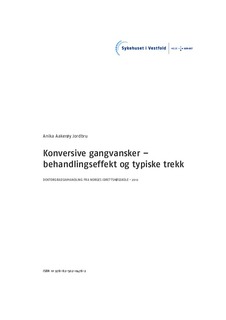| dc.contributor.author | Jordbru, Anika A. | |
| dc.date.accessioned | 2013-12-16T09:47:12Z | |
| dc.date.available | 2013-12-16T09:47:12Z | |
| dc.date.issued | 2012 | |
| dc.identifier | Seksjon for kroppsøving og pedagogikk / Department of Physical Education | |
| dc.identifier.isbn | 978-82-502-0478-2 | |
| dc.identifier.uri | http://hdl.handle.net/11250/171361 | |
| dc.description | Avhandling (doktorgrad) - Norges idrettshøgskole, 2012 | no_NO |
| dc.description.abstract | Avhandlingen omhandler identifikasjon og behandling av konversive gangvansker,
definert som tap av gangfunksjon uten påviselig kroppslig årsak. Den består av en
sammenfatning og tre artikler. Sammenfatningen inneholder en historisk
gjennomgang fra egyptiske papyrusruller (ca 1900 år f. k) og antikkens Hellas, via
hysteriets ”gullalder” i Norge på 1800-tallet til dagens medisinske status. Deretter
gjennomgås de ulike diagnostiske kriterier, hypoteser om årsaker, forekomst og
behandling. Det teoretiske rammeverket består av fire ulike teorier; kognitiv
aktiveringsteori om stress, adferds- og læringsteori, kognitiv atferdsterapi og
fenomenologi. Teoriene kan bidra til å forstå hvordan symptomene oppstår og
vedlikeholdes, samt hvordan rehabiliteringen kan virke. Diagnostikken baseres i
hovedsak på fravær av somatisk sykdom, og det savnes enkle, anvendbare
beskrivelser av positive indikatorer på konversive gangmønstre, som kan brukes i
klinikken. Likeledes er det svært begrenset kunnskapsbase for hva slags behandling
som er virksom. / This dissertation concerns identification and treatment of conversion gait, defined as
reduced walking ability without an organic cause. The dissertation consists of a
historical review from Egyptian papyrus (about 1900 BC k), through ancient Greece,
the golden age" of hysteria in Norway (about 1800s) and up to the medical status of
today. The diagnostic criteria, hypotheses about causes, incidence and treatment are
presented. The theoretical framework consists of these theories; cognitive activation
theory of stress (CATS), learning and behavioural theory, cognitive behavioural
therapy (CBT) and phenomenology. These four theories may contribute to an
understanding of how symptoms accrue, are maintained and finally how rehabilitation
may help. Diagnosis is based mainly on the absence of physical illness, and simple
principles for positively identification of typical gait disturbance are lacking. The
knowledge base on effective treatment is arbitrary and limited. | no_NO |
| dc.description.abstract | Paper I: AA Jordbru, E Jespersen, EW Martinsen.
Conversion gait disorder – Meeting patients in behaviour,
reuniting body and mind.
Sport, Ethics and Philosophy, Vol.2, No 2 2008 | |
| dc.description.abstract | Paper II: AA Jordbru, LM Smedstad, VP Moen, EW Martinsen.
Identifying patterns of psychogenic gait by video recordings
Journal of Rehabilitation Medicine, 2012; 44(1): 31-35 | |
| dc.description.abstract | Paper III: Tatt ut av filen i Brage p.g.a. copyright-restriksjoner. / Not in the file in Brage because of copyright issues. | |
| dc.language.iso | nob | no_NO |
| dc.subject | gang | no_NO |
| dc.subject | fysisk funksjonshemmede | no_NO |
| dc.subject | rehabilitering | no_NO |
| dc.title | Konversive gangvansker: Behandlingseffekt og typiske trekk | no_NO |
| dc.type | Doctoral thesis | no_NO |
| dc.subject.nsi | VDP::Humanities: 000::Philosophical disciplines: 160 | no_NO |
| dc.subject.nsi | VDP::Social science: 200::Social science in sports: 330 | no_NO |
| dc.subject.nsi | VDP::Medical disciplines: 700 | no_NO |
